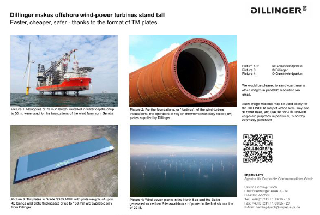New Product Dillinger makes offshore wind-power turbines stand tall
페이지 정보
작성자 최고관리자 댓글 0건 조회 4,349회 작성일 19-05-29 17:21본문

Climate-friendly electricity from the North Sea and the Baltic is gaining ground continuously. The wind-power plants in these locations generated more than 9 terawatt-hours of power in the first six months of 2018. For the foundations, or “footings”, of the wind-turbine installations, the operators of wind farms currently existing or at the planning stage largely rely on thermomechanically rolled (TM) plates supplied by Dillinger, Europe’s leading producer of heavy plate. The decisive reason for this is the plate weight of up to 42 tonnes and plate thicknesses of up to 150 mm, available in Grade S355 M/ML only from Dillinger. In combination with the suppliable plate widths of up to 4,600 mm and this steel’s extremely good workability properties, these plates open up wide-ranging potentials for exceptionally cost-efficient fabrication. One example of this is provided by the 150 turbines of Gemini, off the Dutch coast - one of the world’s largest and most productive offshore wind farms.
The globally rising use of offshore wind energy is continuously increasing the already high cost pressure exerted on operators. TM plates from Dillinger and the associated welding processes thus play key roles in the cost-effective construction of monopiles, currently by far the most frequently selected foundation type. A large number of longitudinal and circumferential welds is necessary for closure of the shell sections and their subsequent joining to form completed monopiles. Automated high-performance welding processes incorporating high deposition rates are therefore used to achieve the necessary efficiency. The preferred process here is submerged-arc welding (SAW), frequently using multiple wire electrodes, in order to maximize deposition rate. Not only cost-effectiveness but also its extremely low susceptibility to welding defects argue in favour of this process, particularly in view of the large wall thicknesses typical of the plates used for monopiles. The preconditions for this are materials which can tolerate these extreme deposition rates without any sacrifice in finished quality, however.
- TEL: +49(0)241-189-25-10
- http://www.impetus-pr.de












